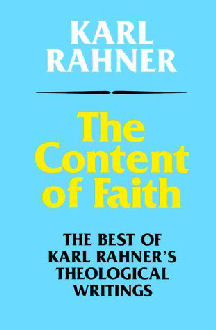
|
Posted July 20, 2005
Book: The Content of Faith: The Best of Karl Rahner’s Theological Writings Editors: Karl Lehmann, Albert Raffelt, and Harvey D. Egan Crossroad, New York, pp. 668 An Excerpt from the Jacket:
The volume consists of 174 selections grouped under eight headings, covering the full spectrum of Christian theology from theological anthropology to eschatology. Approximately forty-five percent of the material comes from the twenty-three volumes of Theological Investigations with the remainder, in large measure, from books that are no longer available except in libraries. Twelve of the selections have never appeared in English before — five of them, for example, having been published in the five-volume Handbuch des Pastoraltheologie, which has not been translated to this day. The aim of the book is “to guide people to Rahner’s spirituality and thought, with as much authenticity and diversity as possible” to present Rahner’s thought, to the extent that this is humanly feasible (there are some four thousand items in his bibliography), “whole and unabridged.” All the essential perspectives and dimensions of his theological work have been brought into play: his unique, experimental style of thinking; his thorough (but generally unobtrusive) familiarity with Scripture, the church fathers, and medieval theology; his way of defining fathers, and medieval theology; his way of defining concepts precisely; his critical objections in the area of church life and politics; and the spiritual inexhaustibility of his intimate writings on prayer. The selections themselves are introduced by a forty-one page “Portrait” of Rahner by Bishop Lehmann, providing a masterful summary of his life and the history of his thought, a profile of the basic structure of his theology, and an appreciation f his incalculable contribution to the life of the church and the course of theology in the twentieth century. An Excerpt from the Book: Internal Threat to the Faith In addition to external dangers to faith, there is the much more significant internal threat that arises out of faith itself. Those who radically and honestly raise the ultimately unavoidable question about the meaning of life, provided of course that they do not grasp on to some illusory or inadequate answer, find their ordinary everyday existence shattered. What was self-evident becomes questionable. What until now was not thought about or reflected on, taboos like serious guilt, the voice of conscience, or death as the “end,” can no longer be repressed or declared irrelevant. The experience of a “threat” of this kind belongs to the basic phenomena of human existence; it is something that a “mature atheist” (Milan Machovec) can experience in his or her own life. Believers, going, as they do, beyond themselves and their own narrow opinions and finding the meaning of life in the infinite God, experience this sense of the abyss and of groundlessness in human life in a particularly intense way. They are also aware of their own weakness and of what it means to fall back into themselves and their egoism’ the understand middle-class smugness and blindness in face of the inescapable puzzles of existence. They readily admit this threat to faith. The experience the free decision of faith as an ever new risk, the risk of finding in God a clear, comprehensive and radically demanding conviction about the meaning of life. Christians know that only God can protect believers from being overwhelmed by this “threat.” And so they admit the possibility and the fact that a person can doubt, deny and lose his or her faith. That, however, does not lessen faith’s own existential sureness and firmness. Both belong to its essence. The acceptance of this characteristic of it could be called knowledge about the threat that is always a part of it, a threat to which Christians courageously and truly expose themselves. Table of Contents 1. What is Christianity? 2. The Mystery of Existence 3. The Living God 4. Jesus Christ 5. The Holy Spirit 6. The People of God in History 7. Christian Life 8. Hope in God |
|
